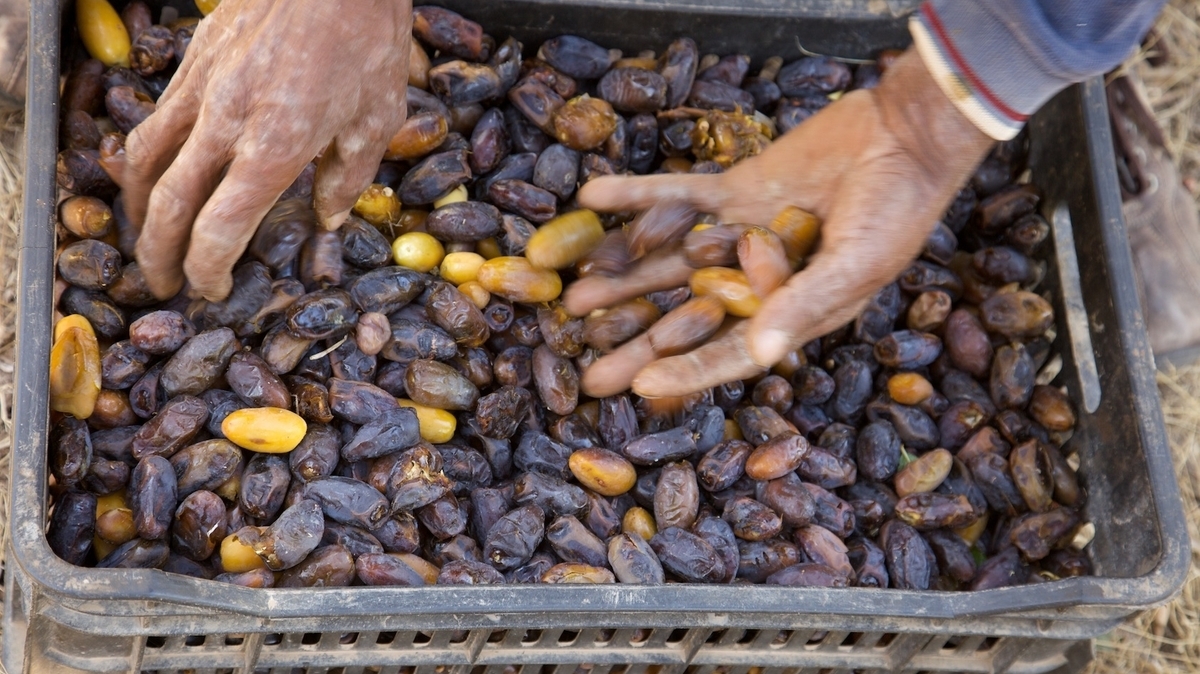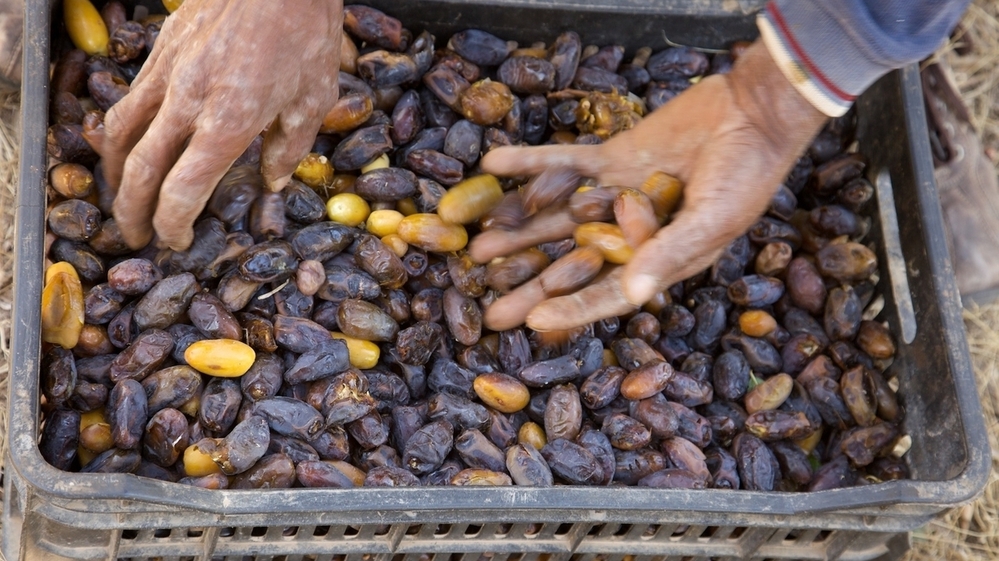A Moroccan date harvester sorts his yield, which was well above average this year.
A Moroccan date harvester sorts his yield, which was well above average this year.
Jeff Koehler/Jeff KoehlerIn the heart of the Moroccan oasis and palm grove of Skoura, west of Marrakesh, yellow and reddish dates dangled heavily from branches high above us. It's going to be a good year, a man harvesting dates said, offering me a handful of fresh, still-yellow fruit cut from the tree just moments before.
The man, holding a tamskart, a hooked knife anchored to a short wooden handle used for trimming these heavily laden branches, had just shimmied down from one of a dozen palm trees. He was paid 20 dirham, or just over $2, per tree by the family that owns them. It's a dangerous and labor-intensive job.
Whole sprays of yellow dates, as well as mounds of riper, sticky brown ones that had shaken loose from the trees were splayed across blue tarps. They were Bouskri, a favorite variety here that is dried and best when the brittle skin shatters as you bite into it. Eaten fresh, they tend to be a touch woody in taste and texture.
I had gone to Skoura in early October to catch the beginning of the date harvest. Wandering around the palm grove, everyone told me the same thing: This harvest would be better than average and much better than the previous year.
It took two months to bring in Skoura's dates. Now that the harvest is over, how did it turn out?
Those I met in Skoura were right. According to a United Nations Food and Agriculture Organization report, the country's recent date harvest was expected to be 10 percent above the average of the past five years.
That's good news for the family farmers in Skoura, who keep the dates they'll use throughout the year and sell the excess from the harvest in the town's Monday souk.
Dates hold pride of place on the Moroccan table. Hosts traditionally offer the fruits to guests with a glass of milk, especially during the year's important holidays. The fruits are eaten out of hand, used in desserts and for topping sweet couscous, but also find their way into the country's famed lamb and poultry tagine stews. The average Moroccan eats about 6 1/2 pounds of dates each year, though in date-producing areas, that figure reaches some 33 pounds.
They are also the first item eaten with the breaking of the fast during the month of Ramadan, and controversies have erupted over where dates were imported from to meet holiday demands. About half of all dates in Morocco are eaten during this holiday.
This year, Morocco's date haul weighed in at 110,180 metric tons, according to Morocco's agriculture ministry. In Ouarzazate, near Skoura, the yield leaped from a five-year average of 56,000 tons to 65,000 tons. Nearly 90 percent of the country's dates are grown in this region and Errachidia, which lies farther east at the edge of the Sahara.
So why the dramatic increase?
Morocco's agricultural ministry sees the good harvest as a confirmation of the momentum of the country's ambitious, wide-ranging "Plan Maroc Vert" (Green Morocco Plan), outlined in 2008 to stimulate, expand and modernize various agricultural sectors. For dates, the goal has been to significantly increase production, reaching 160,000 tons in 2020.
After decades of decline from disease and drought, the amount of land used to grow dates now has effectively shrunk by half since the mid-1940s. And so the project focuses on fighting bayoud disease â€" a fungus widespread in Morocco that quickly kills the tree â€" and increasing plantings. In each of the past three years, more than 400,000 palms were planted.
That alone, though, probably can't account for the significant jump in this year's crop, especially as many of those plantings have yet to bear fruit.
Was it the weather?
Monika Tothova, an economist with the FAO, tells The Salt by email that the rainfall in the oases that help irrigate the dates was "beneficial," which is actually more striking than it might sound. In the FAO report, the organization contrasted the date harvest boom with the steep agricultural declines in other sectors. Grains were down 38 percent compared with last year, and citrus was 25 percent below the five-year average, because of heat waves, droughts and cold spells.
But for many involved in the date harvest I met in Skoura, even favorable weather was not the full reason for the year's bountiful crop.
"It is the will of Allah," the man cutting trees with a tamskart told me.
With that, he looked up at the heavy clusters of dates awaiting his knife and began to nimbly scale the trunk of another palm tree.
Jeff Koehler is the author of Morocco: A Culinary Journey with Recipes. His next cookbook, on Spain, will be published in 2013. Visit www.jeff-koehler.com or follow @koehlercooks.




